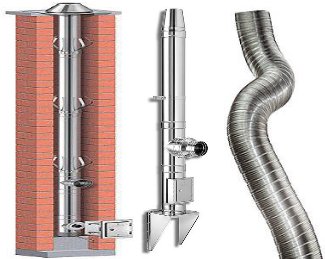 When the chimney silts up, it is high time for a renovation. We show the causes and the solutions for the damage to the fireplace.
When the chimney silts up, it is high time for a renovation. We show the causes and the solutions for the damage to the fireplace.
Brick chimneys in houses used to be built for other fuels or higher outputs. For stone- or lignite heating or older, oversized boilers, these old trains were still adequately dimensioned. The higher exhaust gas temperature heated up the train evenly and then ensured a strong draft in the chimney. It wasn't just the exhaust fumes, but also the moisture it contains is reliably led out of the chimney.
With the continuously developed heating technology and the triumphant advance of the Nieder- and cryogenic boilers a technical problem arose, To which too little attention was paid when installing a modern boiler: the chimney moisture penetration and sooting.
The reason for this is the low exhaust gas temperature of these systems. It does improve the efficiency of the fireplace, which thus works in an energy-saving and environmentally friendly way, but at the same time it also worsens the operating conditions for the chimney draft. Because, the better the combustion and the lower the exhaust gas temperature, the less moisture can be transported out of the train with the exhaust gases. The consequence is damage caused by moisture penetration.
But that happens particularly easily in the old trains with large cross-sections, if a low-temperature boiler is connected to it. Therefore, when installing a new boiler, the chimney usually has to be refurbished as well. There are renovation systems for this, which can be installed inside the old train without major structural changes. Insertion tubes made of stainless steel are most frequently used. However, there are also systems made of plastic, Glass and fireclay ears.
Renovation with a system
With the push-in rehabilitation systems, a train is installed in the train, so to speak. Due to the smaller diameter of these systems, the large existing chimney cross-section is reduced and thus the passage of flue gases is improved. Because of the extremely low flue gas temperatures of condensing boilers and the particularly effective use of the energy used, special requirements are placed on flue systems for condensing boilers. This is why these devices are usually equipped with an additional fan, which creates an overpressure in the chimney. The consequence: The exhaust gases are blown out of the chimney.
For safety reasons, the exhaust system must therefore be pressure-tight. The plastic systems meet these requirements, because they have a sealing ring at the transition from pipe to pipe. However, they are only suitable for the very low flue gas temperatures of condensing boilers. Corresponding systems are also available made of stainless steel.
Noble material stainless steel
The vast majority of the newly installed boilers in Germany are low-temperature boilers. Their exhaust gases still have sufficient residual heat, to ensure sufficient draft without additional support. Refurbishment systems made of stainless steel have proven particularly effective for these boilers. They too are let into the old train from the chimney head and fixed there. There are prefabricated molded parts for the connection area to the boiler and for the inspection opening for the chimney sweep. Special cover plates and rain collars are provided for the chimney head in the area of the cover plate, which protect the old chimney draft from driving rain.
There are also renovation systems made of glazed or unglazed chamotte elements in a similar design. They too are installed element by element through the chimney.
All renovation measures must be coordinated with the responsible district chimney sweep before starting work and should only be carried out by a specialist company.